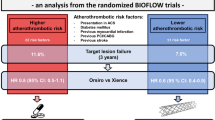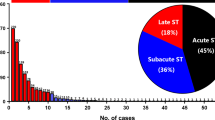Abstract
Drug-eluting stents (DES) reduce the incidence of in-stent restenosis (ISR) after primary percutaneous coronary intervention (PCI) for ST-elevation myocardial infarction (STEMI). Whether the use of biomarkers might be of utility to identify patients who remain at risk for DES ISR after primary PCI has never been examined. A total of 26 biomarkers were measured at enrollment and 30 days and analyzed at a central core laboratory in 501 STEMI patients from the HORIZONS-AMI trial. All patients underwent primary PCI with the TAXUS paclitaxel-eluting stent (PES), were scheduled for routine angiographic follow-up at 13 months, and were followed for 3 years. Mean in-stent late-loss was 0.28 ± 0.57 mm, and target lesion revascularization (TLR) at 3 years occurred in 9.1 % of patients. Low levels of interleukin-6 (IL-6) and placental growth factor (PLGF) at admission were associated with both higher in-stent late loss and ischemia-driven TLR. Additionally, low admission levels of cardiotrophin-1 (CT-1) were associated with higher rates of ischemia-driven TLR. At 30-day follow-up lower values of IL-1ra (IL-1ra), matrix metalloproteinase 9 (MMP9), and myeloperoxidase (MPO), and a decline relative to admission in IL-1ra, monocyte chemotactic protein-1 (MCP-1), and MMP9 were associated with higher in-stent late loss. Low values of IL-6 at 30 days were also associated with ischemia-driven TLR. After multivariate adjustment, only MPO at 30 days and a decline of MCP-1 between admission and 30 days were associated with in-stent late loss, and only CT-1 was associated with TLR. MPO at 30 days and a decline of MCP-1 between admission and 30 days were independently associated with in-stent late loss, and CT-1 was associated with TLR. Additional studies to confirm and validate the utility of these biomarkers are warranted.

Similar content being viewed by others
References
Stone GW, Grines CL, Cox DA et al (2002) Comparison of angioplasty with stenting, with or without abciximab, in acute myocardial infarction. N Engl J Med 346:957–966
Brar SS, Leon MB, Stone GW et al (2009) Use of drug-eluting stents in acute myocardial infarction: a systematic review and meta-analysis. J Am Coll Cardiol 53:1677–1689
De LG, Stone GW, Suryapranata H et al (2009) Efficacy and safety of drug-eluting stents in ST-segment elevation myocardial infarction: a meta-analysis of randomized trials. Int J Cardiol 133:213–222
Dangas GD, Claessen BE, Caixeta A, Sanidas EA, Mintz GS, Mehran R (2010) In-stent restenosis in the drug-eluting stent era. J Am Coll Cardiol 56:1897–1907
Libby P, Clinton SK (1992) Cytokines as mediators of vascular pathology. Nouv Rev Fr Hematol 34(Suppl):S47–S53
Hwang CW, Levin AD, Jonas M, Li PH, Edelman ER (2005) Thrombosis modulates arterial drug distribution for drug-eluting stents. Circulation 111:1619–1626
Mehran R, Brodie B, Cox DA et al (2008) The Harmonizing Outcomes with RevasculariZatiON and Stents in Acute Myocardial Infarction (HORIZONS-AMI) Trial: study design and rationale. Am Heart J 156:44–56
Stone GW, Witzenbichler B, Guagliumi G et al (2008) Bivalirudin during primary PCI in acute myocardial infarction. N Engl J Med 358:2218–2230
Stone GW, Lansky AJ, Pocock SJ et al (2009) Paclitaxel-eluting stents versus bare-metal stents in acute myocardial infarction. N Engl J Med 360:1946–1959
Stone GW, Witzenbichler B, Guagliumi G et al (2011) Heparin plus a glycoprotein IIb/IIIa inhibitor versus bivalirudin monotherapy and paclitaxel-eluting stents versus bare-metal stents in acute myocardial infarction (HORIZONS-AMI): final 3-year results from a multicentre, randomised controlled trial. Lancet 377:2193–2204
Nutritional anaemias (1968) Report of a WHO scientific group. World Health Organ Tech Rep Ser 405:5–37
Cockcroft DW, Gault MH (1976) Prediction of creatinine clearance from serum creatinine. Nephron 16:31–41
Huber SA, Sakkinen P, Conze D, Hardin N, Tracy R (1999) Interleukin-6 exacerbates early atherosclerosis in mice. Arterioscler Thromb Vasc Biol 19:2364–2367
Kleemann R, Zadelaar S, Kooistra T (2008) Cytokines and atherosclerosis: a comprehensive review of studies in mice. Cardiovasc Res 79:360–376
Schieffer B, Selle T, Hilfiker A et al (2004) Impact of interleukin-6 on plaque development and morphology in experimental atherosclerosis. Circulation 110:3493–3500
Pennica D, King KL, Shaw KJ et al (1995) Expression cloning of cardiotrophin 1, a cytokine that induces cardiac myocyte hypertrophy. Proc Natl Acad Sci USA 92:1142–1146
Khurana R, Moons L, Shafi S et al (2005) Placental growth factor promotes atherosclerotic intimal thickening and macrophage accumulation. Circulation 111:2828–2836
Heeschen C, Dimmeler S, Fichtlscherer S et al (2004) Prognostic value of placental growth factor in patients with acute chest pain. J Am Med Assoc 291:435–441
Feldman LJ, Mazighi M, Scheuble A et al (2001) Differential expression of matrix metalloproteinases after stent implantation and balloon angioplasty in the hypercholesterolemic rabbit. Circulation 103:3117–3122
Bendeck MP, Zempo N, Clowes AW, Galardy RE, Reidy MA (1994) Smooth muscle cell migration and matrix metalloproteinase expression after arterial injury in the rat. Circ Res 75:539–545
Nicholls SJ, Hazen SL (2005) Myeloperoxidase and cardiovascular disease. Arterioscler Thromb Vasc Biol 25:1102–1111
Dibra A, Ndrepepa G, Mehilli J et al (2005) Comparison of C-reactive protein levels before and after coronary stenting and restenosis among patients treated with sirolimus-eluting versus bare metal stents. Am J Cardiol 95:1238–1240
Ferrante G, Niccoli G, Biasucci LM et al (2008) Association between C-reactive protein and angiographic restenosis after bare metal stents: an updated and comprehensive meta-analysis of 2747 patients. Cardiovasc Revasc Med 9:156–165
Lee SW, Park SW, Kim YH et al (2011) A randomized, double-blind, multicenter comparison study of triple antiplatelet therapy with dual antiplatelet therapy to reduce restenosis after drug-eluting stent implantation in long coronary lesions results from the DECLARE-LONG II (drug-eluting stenting followed by cilostazol treatment reduces late restenosis in patients with long coronary lesions) trial. J Am Coll Cardiol 57:1264–1270
Lee SW, Park SW, Kim YH et al (2008) Drug-eluting stenting followed by cilostazol treatment reduces late restenosis in patients with diabetes mellitus the DECLARE-DIABETES trial (a randomized comparison of triple antiplatelet therapy with dual antiplatelet therapy after drug-eluting stent implantation in diabetic patients). J Am Coll Cardiol 51:1181–1187
Conflict of interest
The HORIZONS-AMI trial was supported by the Cardiovascular Research Foundation, with grant support from Boston Scientific and the Medicines Company. Dr. Dangas and has received speaker honoraria from Astra Zeneca, Bristol-Meiers Squibb, The Medicines Co, Sanofi Aventis, and Abbott Vascular. Dr Mehran has received a research grant from Sanofi Aventis, and honoraria from The Medicines Company, Abbott Vascular, Sanofi Aventis, Bristol Meiers Squibb, Cordis, and Astra Zeneca. Dr. Witzenbichler has received lecture honoraria from Boston Scientific and The Medicines Company. Dr. Guagliumi has served as a consultant Boston Scientific and Volcano, and has received lecture honoraria from Boston Scientific, Medtronic, Lightlab, Labcoat, and receiving grant support from Medtronic and Boston Scientific. Dr Brodie is in the Speakers Bureau of the Medicines Co. Dr. Stone is on the scientific advisory boards for and has received honoraria from Abbott Vascular and Boston Scientific, and has served as a consultant to the Medicines Company, Eli Lilly BMS/Sanofi and AstraZeneca. The other authors report no conflicts.
Author information
Authors and Affiliations
Corresponding author
Electronic supplementary material
Below is the link to the electronic supplementary material.
Rights and permissions
About this article
Cite this article
Claessen, B.E., Stone, G.W., Mehran, R. et al. Relationship between biomarkers and subsequent clinical and angiographic restenosis after paclitaxel-eluting stents for treatment of STEMI: a HORIZONS-AMI substudy. J Thromb Thrombolysis 34, 165–179 (2012). https://doi.org/10.1007/s11239-012-0706-x
Published:
Issue Date:
DOI: https://doi.org/10.1007/s11239-012-0706-x




